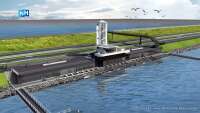Leo J.F. de Ruiter Review of 't Monument, Afsluitdijk
The Afsluitdijk, there is no other name, is an ico...
The Afsluitdijk, there is no other name, is an icon for Dutch water management. The dike represents the Dutch battle against water and is the calling card of the famous Dutch hydraulic engineering. Rijkswaterstaat and the De Nieuwe Afsluitdijk partnership are working together on the Afsluitdijk to make it stronger and more attractive. Locks for shipping and discharge sluices are located on both sides of the Afsluitdijk. The Stevinsluizen are located against Noord-Holland. The Lorentz locks are located on Kornwerderzand, more than 4 km from Friesland. The entire dike is 32.5 km long, the water-retaining part of it 30 km. A traffic road runs across the Afsluitdijk, connecting both provinces (North Holland and Friesland). On the Afsluitdijk are several monuments, including the so-called Vlietermonument and the statue of Ir. Cornelis Lely, the architect of the Zuiderzee Works and therefore also of the Afsluitdijk. The monuments can be visited, at the Vlietermonument there is parking and a souvenir shop and lunchroom, called the Monument. The Vlietermonument is located at the Vlieter, the place where the Afsluitdijk was closed in 1932. It is a monument in the form of a watchtower, designed by architect Willem Dudok. Not much can be said about the monuments and statues, they are beautiful works of art. When you enter the tower you have a beautiful view over the dike and the water on both sides of the dike. In the lunchroom you can buy something to eat and drink, the prices are very real. There are various sandwiches, sandwiches, bouncers, omelettes, soup, pancakes, fries and snacks, so you don't have to starve and it is tasty as from a snack bar.
The very first plans for closing off the Zuiderzee date back to the 17th century. At that time, however, the knowledge and technology were far from ripe. In 1891, the young engineer Lely worked out the first viable plans for the Afsluitdijk. In 1913, as Minister of Water Management, he made sure that the project was placed on the cabinet's agenda. Nevertheless, the cabinet decided to postpone these plans. The first work on the Afsluitdijk started in 1920. After a short stop due to a deteriorating economic situation, work accelerated in 1925. More than 30 kilometers of dike in the middle of the sea. In 1932 the last hole in the Afsluitdijk was finally closed.

Comments: